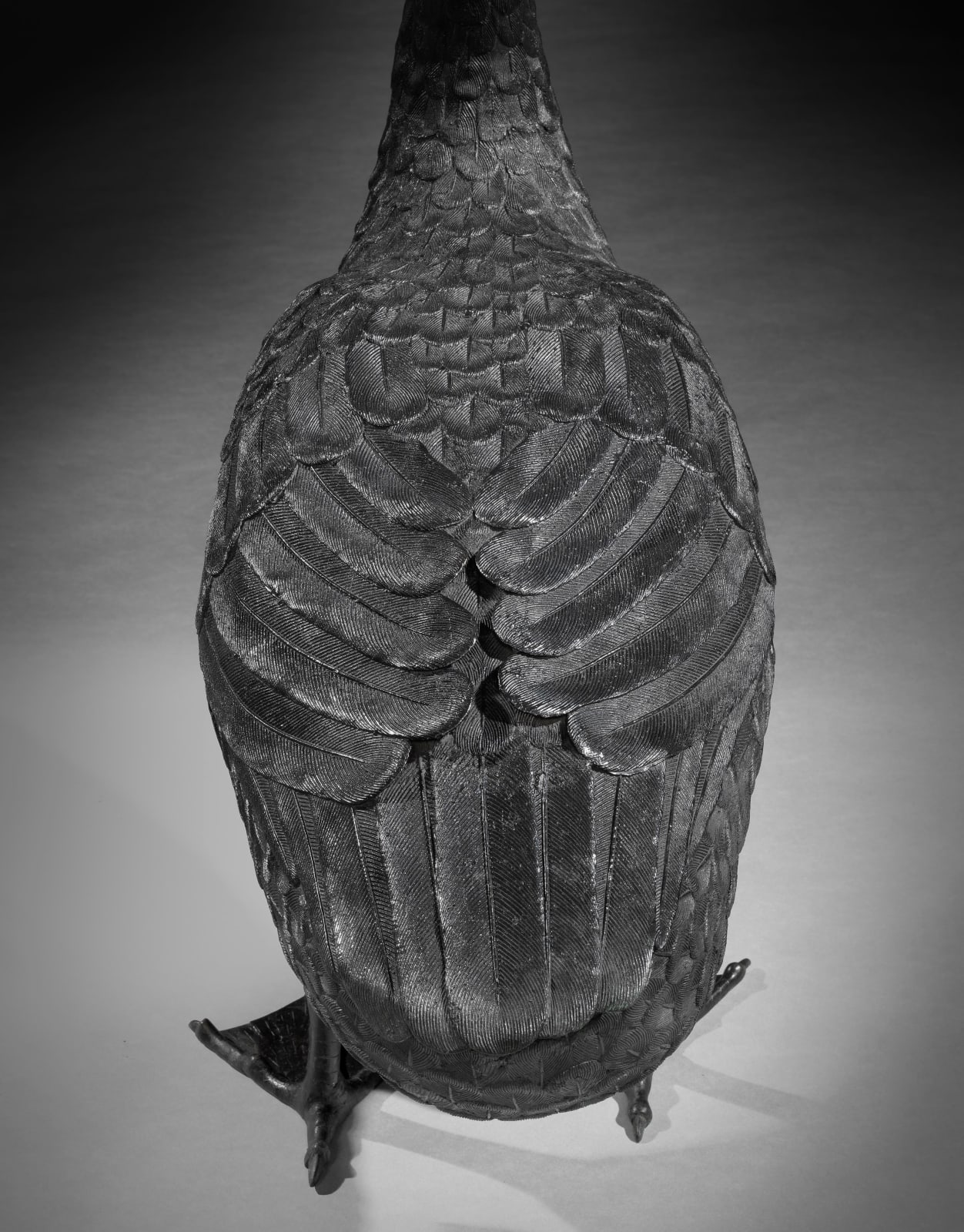WORKS FOR SALE
A PAIR OF JAPANESE BRONZE FIGURES OF GEESE
Width: 22.85” 58cm
Further images
Provenance
Charlie Chaplin, Corsier-sur-Vevey, Lake Geneva, Switzerland
Distinguished Private Collection: London, UK
Literature
Joe Earle, Splendors of Meiji: Treasures of Imperial Japan from the Khalili Collection, The Khalili Family Trust, 1999.
Oliver Impey and Malcolm Fairley, Meiji no Takara: Treasures of Imperial Japan – Metalwork, 2 vols., The Nasser D. Khalili Collection of Japanese Art, 1995.
Suzuki, Daisetz T., Zen and Japanese Culture, Princeton University Press, 1959.
Christine Guth, Art, Tea and Industry: Masuda Takashi and the Mitsui Circle, Princeton University Press, 1993
A Rare and striking pair of life size Japanese Bronze Geese
Japanese: Early 19th Century
Late Edo Period (1604-1868) - Meiji period (1868 -1912)
This exceptional pair of life-size bronze geese captures the naturalistic vitality and technical brilliance for which Japanese bronze sculpture is celebrated. Each bird is modelled with its head raised and beak agape in mid-cry, conveying a vivid sense of animation and alertness. The intricately chased plumage, textured with extraordinary finesse across the surface, enhances the impression of realism, while the subtle differentiation in posture and the carefully rendered webbed feet attest to the sculptor’s intimate observation of the natural world.
These geese are reflective of the flourishing bronze artistry of the Late Edo Period and early Meiji period (1868–1912). It was a time when Japanese metalwork reached unprecedented heights in response to domestic and international demand.
Symbolism and Poetic Meaning in Japanese Culture
In Japanese culture, the goose (kari, 雁) holds profound poetic and philosophical significance. Celebrated for its grace, fidelity, and migratory rhythms, the goose embodies ideals of marital harmony, spiritual constancy, and refined natural beauty. Geese’s lifelong bonds have made them a symbol of loyalty and domestic stability, while their graceful flight evokes the contemplative mood of mono no aware, which was the awareness of life’s impermanence, and the importance of seizing the day.
Geese also appear throughout classical poetry, Zen painting, and bronze sculpture, and are often seen in temple and literati contexts, where they were placed to represent serenity, introspection, and a harmonious connection to the natural world.
When shown as a pair as in the present example, they communicate ideals of enduring unity and cultivated elegance, these were values that are deeply embedded in the Japanese aesthetic tradition. Here, the open beaks of the geese in mid-call convey a moment of vivid communication, heightening their sense of animation and emotional immediacy, and imbuing these sculptures with both naturalistic vitality, and symbolic resonance.
Comparable Examples and Museum Context
Bronze sculptures of this scale, refinement, and naturalistic vitality are exceptionally rare and were produced by only the most accomplished Japanese metalworkers of the 19th century. A closely related pair of bronze cranes in the Musée Guimet, Paris shares the same sense of sculptural presence, elegant restraint, and exquisite detail. Their commanding stillness and naturalism reflect similar artistic priorities to those seen in the present geese: symbolism, technical mastery, and expressive realism.
Several other works of similar date highlight the calibre and aesthetic spirit of the present pair. These include a life-size bronze goose formerly in the Hosomi Museum, Kyoto, attributed to a Kyoto school metalworker; a standing bronze crane in the Tokyo National Museum, notable for its finely chiselled plumage and poised silhouette; and a pair of temple garden cranes in the Nezu Museum, distinguished by their anatomical realism and contemplative character.
Further parallels can be drawn with a life-size bronze goose attributed to the Miyao Company, now in the Los Angeles County Museum of Art (LACMA), which shares comparable scale and detailed surface work. A spirited bronze goose in the Museum of Fine Arts, Boston, though slightly smaller, exemplifies the same expressive energy. Finally, a pair of open-beaked bronze geese from the Richard R. Silverman Collection, illustrated in Meiji: Japanese Art from the Imperial Period, also demonstrate the dynamic featherwork and vivid animation found in the present sculptures.
Significance
This pair of geese belongs to a small and distinguished group of 19th-century Japanese bronze animal sculptures that combine meticulous naturalistic observation with profound symbolic meaning. They reflect a level of artistic ambition and technical refinement achieved only by the most accomplished sculptors of the period.
Likely intended for a temple garden, a literati scholar’s retreat, or a sophisticated private residence, they embody the poetic subtlety and sculptural depth that characterise the finest achievements in Japanese bronze artistry.
Their life-size scale, superb condition, and the rare survival of the pair as a complete ensemble elevate their significance. At once serene and commanding, they are a fusion of naturalism, symbolism, and craftsmanship, resonating deeply with connoisseurs and scholars alike.





